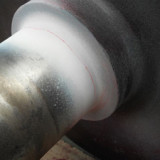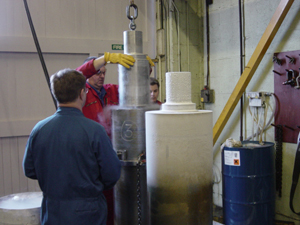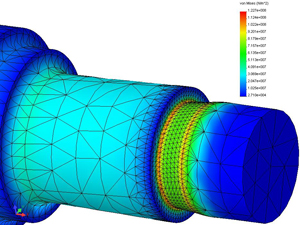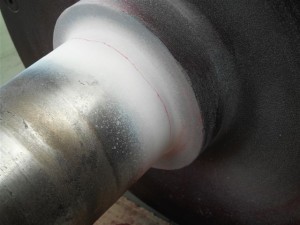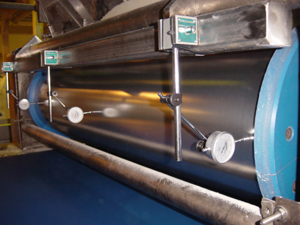Sheeter Roll Fatigue Crack for Repair
Rollers can be repaired after a fatigue failure at the bearing journal
Sheeting rolls are subject to massive loads and high strains. Also, as the rolls rotate they are subject to a cyclic fatigue mechanism. Eventually, given the right combination of load, speed and time the roll will fail not by overload but by fatigue.
Typically, rolls have a shoulder on the journal to position a bearing. The majority of failures occur at this shoulder rather than the centre of the roll. This is the point of maximum stress. The failure starts as a surface crack. It migrates at a slow pace towards the centre of the journal. The crack reaches a certain diameter where the stress exceeds the material’s strength and the roll fails instantly.
Surface crack detection systems can be used to prevent roll failures. Usually, the rolls have to be removed from the machine for inspection and this makes prevention unattractive. Measuring roll deflections can be used to estimate roll loading, and hence, stress. Care is required to take out bearing clearance from any roll deflections.
Having established or estimated stresses at the bearing shoulder, a review of the design can be made. Here, shaft diameter and material selection are evaluated for service life and strength. The key material parameter is endurance limit. Typically, for steels the endurance limit is about 45% of the ultimate strength. To prevent roll failure the maximum peak stress must remain below the endurance limit.
The easiest way to reduce stress for a given load is to increase the shaft diameter. This does not necessarily mean new rolls. In the case of the potato chip sheeter we were able to modify the existing rolls by removing the original journals and fitting new. Arrow’s preferred assembly technique for roll manufacture is to use liquid nitrogen to shrink the journal into its roll. We do employ other assembly techniques such as a flanged bolt-in journal. However, this is used for lighter duty roll construction. One major advantage of shrink-fitting journals is that a material stronger than the original roll can be used to help offset the increase in diameter.
Roll diameter is governed by the bearing centre span in order to minimise roll deflection. A good roll design should conform to the one-third rule. The bearing journal should be at least one-third the diameter of the roll. Bearing selection can play an important part in roll performance. At Arrow we use spherical roller bearings on sheeting rolls. This type of bearing eliminates the bending (or resisting) moments at the ends of the rolls and ensures that the reaction-forces are directed in line with the sheeter side-frames.
If you would like to know more about our advanced products, then please call us.
Key Features
- Shaft diameter should be large enough to keep peak stress below endurance limit at the bearing journal.
- Select a journal material that has a good endurance limit.
- Use a spherical roller bearing for high load applications. Pre-load bearing for optimum performance.

